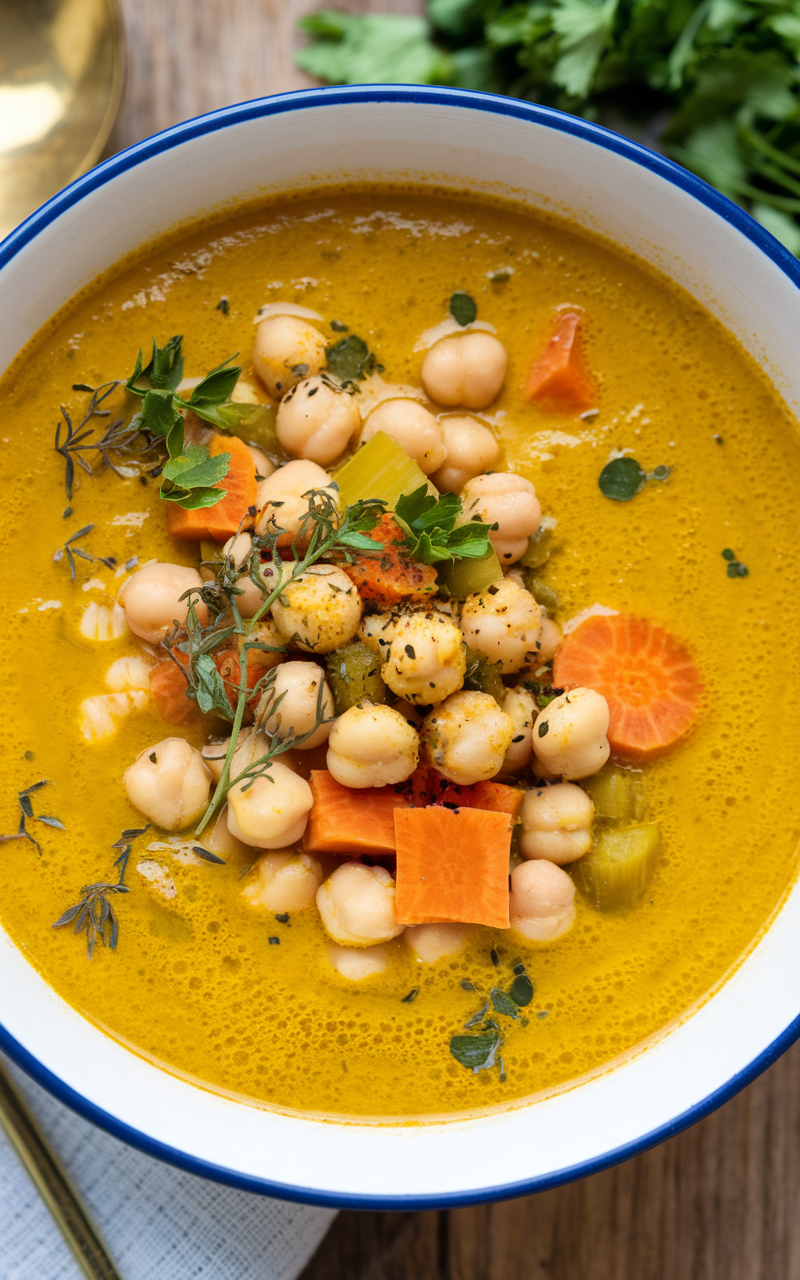Anti-Inflammatory Chickpea and Turmeric Soup
Ingredients for Anti-Inflammatory Chickpea and Turmeric Soup (Serves 2)
This wholesome soup is not only delicious but packed with anti-inflammatory ingredients that can help improve overall health. The key components of this soup work synergistically to provide flavor and nutrition.
Essential Ingredients
- Chickpeas: 1 cup of cooked chickpeas, rich in protein and fiber. They add a nutty taste and hearty texture to the soup.
- Turmeric: 1 teaspoon of ground turmeric, a powerful anti-inflammatory and antioxidant spice, responsible for the soup’s vibrant color.
- Vegetable Broth: 2 cups of low-sodium vegetable broth, forming the base of the soup and enhancing its flavor without overwhelming the other ingredients.
- Garlic: 2 cloves, minced. Known for its anti-inflammatory properties, garlic adds a robust flavor.
- Ginger: 1-inch piece of fresh ginger, grated. Its warmth and spiciness complement turmeric while boosting the soup’s health benefits.
Additional Ingredients
- Onion: 1 small onion, finely chopped. It provides a sweet, savory foundation.
- Coconut Milk: 1/2 cup of full-fat coconut milk for creaminess and richness.
- Olive Oil: 1 tablespoon of extra virgin olive oil, used for sautéing and adding healthy fats.
- Spinach: A handful of fresh spinach leaves, added for a boost of vitamins and minerals.
- Lemon Juice: 1 tablespoon, freshly squeezed, to brighten up and balance the flavors.
- Salt and Pepper: To taste. Essential for seasoning and enhancing the overall taste of the soup.
Optional Garnishes
- Fresh Cilantro: Chopped, for an additional burst of freshness and flavor.
- Crushed Red Pepper Flakes: To add a hint of heat for those who enjoy a spicier kick.
- Pumpkin Seeds: Toasted, for a crunchy texture and added nutrients.
Each ingredient in this recipe is selected not only for its flavor but also for its health benefits, making this soup a comforting and nourishing meal that can be enjoyed any time of year.

Step-by-Step Guide to Making Anti-Inflammatory Chickpea and Turmeric Soup
Chickpea and turmeric soup is not only delicious but also packed with nutrients that help reduce inflammation in the body. Here’s a detailed guide to crafting this healthy and hearty soup that you can enjoy any time of the year.
Ingredients You’ll Need
- 2 tablespoons of olive oil
- 1 large onion, chopped
- 3 cloves of garlic, minced
- 1 tablespoon of fresh ginger, grated
- 1 teaspoon of ground turmeric
- 1 teaspoon of ground cumin
- 1/2 teaspoon of ground coriander
- 1/4 teaspoon of cayenne pepper (optional, for a bit of heat)
- 2 cans (15 oz each) of chickpeas, drained and rinsed
- 4 cups of vegetable broth
- 1 can (14 oz) of coconut milk
- Salt and pepper, to taste
- Juice of 1 lemon
- Fresh cilantro, for garnish
Instructions
- Prepare Your Vegetables: Begin by chopping the onion, mincing the garlic, and grating the ginger. These aromatics will form the flavorful base of your soup.
- Sauté the Aromatics: Heat the olive oil in a large pot over medium heat. Add the chopped onion and sauté for about 5 minutes or until it becomes translucent.
- Add Garlic and Spices: Stir in the minced garlic, grated ginger, turmeric, cumin, coriander, and cayenne pepper. Cook for an additional 1-2 minutes until the spices release their aroma.
- Add Chickpeas and Broth: Add the drained chickpeas to the pot, followed by the vegetable broth. Stir well to combine all ingredients.
- Simmer the Soup: Bring the mixture to a boil, then reduce the heat to low and let it simmer for about 20 minutes, allowing the flavors to meld together.
- Blend the Soup (Optional): For a creamier texture, you can use an immersion blender to blend half of the soup, leaving some chickpeas whole for added texture.
- Add Coconut Milk: Stir in the coconut milk, season with salt and pepper to taste, and let it cook for another 5 minutes.
- Finish with Lemon Juice: Remove the soup from heat and stir in the juice of one lemon to brighten the flavors.
Serving Suggestions

Ladle the soup into bowls and garnish with fresh cilantro. This soup pairs well with crusty bread or a side salad for a complete meal.
Health Benefits
This chickpea and turmeric soup is rich in anti-inflammatory ingredients. Turmeric contains curcumin, known for its powerful anti-inflammatory effects. Chickpeas are a great source of plant-based protein and fiber, contributing to overall digestive health. Ginger not only adds depth of flavor but also aids in reducing inflammation.
Storing and Reheating Anti-Inflammatory Chickpea and Turmeric Soup
The anti-inflammatory chickpea and turmeric soup is not only a nourishing meal but also versatile in terms of storage and reheating. Proper techniques can ensure you maintain its flavor and nutritional benefits for days after its preparation. Here’s a comprehensive guide on how to store and reheat this delightful soup.
Storing the Soup
To preserve the quality and safety of your soup, follow these storage tips:
- Cooling: Allow the soup to cool to room temperature before storing it. This prevents the growth of bacteria and ensures the soup doesn’t raise the temperature inside your refrigerator.
- Container Choice: Use airtight containers to store the soup. This helps to prevent contamination and retain the soup’s flavors.
- Refrigeration: Store the soup in the refrigerator if you plan to consume it within 3 to 4 days. Keep the temperature at or below 40°F (4°C).
- Freezing: For longer storage, portion the soup into freezer-safe containers or bags, leaving some space for expansion. The soup can be frozen for up to 3 months.
Reheating the Soup
Reheating the chickpea and turmeric soup requires gentle methods to maintain its texture and nutritional integrity:
- Thawing: If frozen, move the soup to the refrigerator to thaw overnight. This gradual thawing process helps maintain the soup’s consistency.
- Stovetop Reheating: Transfer the soup to a pot and heat it over medium-low heat, stirring occasionally. This method helps keep the chickpeas intact and avoids overcooking the turmeric.
- Microwave Reheating: Place the soup in a microwave-safe bowl. Cover it loosely and heat on medium power in 1-minute intervals, stirring in between to ensure even heating.
- Check Temperature: Ensure that the soup reaches an internal temperature of 165°F (74°C) before serving, to ensure it is heated thoroughly and safely.
With these simple steps, you can enjoy the comforting and healthful benefits of your anti-inflammatory chickpea and turmeric soup anytime, knowing it’s stored and reheated with care.
Perfect Pairings: What to Serve with Anti-Inflammatory Chickpea and Turmeric Soup
The Anti-Inflammatory Chickpea and Turmeric Soup is a delightful blend of flavors and nutrients that not only tantalizes the taste buds but also offers numerous health benefits. To complete the meal, it’s important to choose sides and accompaniments that enhance the soup’s vibrant flavors and complement its nutritious profile.
Bread and Crackers
Pairing the soup with bread or crackers can add a delightful crunch and help soak up the savory broth:
- Whole Grain Bread: Opt for a slice of whole grain or seed-studded bread. The earthy flavors and hearty texture are an excellent match for the rich, creamy soup.
- Sourdough Croutons: Crunchy sourdough croutons bring a contrasting texture while enhancing the soup’s subtle tanginess.
- Gluten-Free Crackers: For those who are gluten-sensitive, a selection of gluten-free crackers provides a crisp accompaniment that complements the soup without overpowering it.
Salads
To add freshness and a nutritional boost, serve the soup alongside a vibrant salad:
- Mixed Greens with Lemon Vinaigrette: A light salad with arugula, spinach, and kale topped with a zesty lemon vinaigrette brings a refreshing contrast to the warm spices of the soup.
- Quinoa and Beet Salad: The earthy flavors of roasted beetroot and nutty quinoa, combined with a hint of citrus, create a harmonious balance with the turmeric seasoning.
- Carrot and Cabbage Slaw: A crunchy slaw dressed with apple cider vinegar adds a crisp texture and a hint of sweetness.
Proteins
For a more filling meal, consider adding a protein-rich side:
- Grilled Chicken Breast: A simple grilled chicken breast, seasoned with herbs, complements the soup’s savory depth without overshadowing its subtle flavors.
- Spiced Lentil Patties: Lentil patties seasoned with cumin and coriander bring additional plant-based protein and a delightful spice profile that echoes the soup’s ingredients.
- Hard-Boiled Eggs: Serve halved hard-boiled eggs to add a creamy texture and a source of high-quality protein.
Beverages
The right beverage can round out your meal perfectly:
- Herbal Tea: A warm cup of herbal tea like ginger or chamomile pairs well with the anti-inflammatory theme, enhancing the meal’s soothing quality.
- Lemon-Infused Water: Refreshing lemon water is not only hydrating but also adds a tartness that refreshes the palate.
- White Wine: A dry white wine, such as Sauvignon Blanc, offers a crisp and clean flavor that complements the aromatic spices in the soup.







